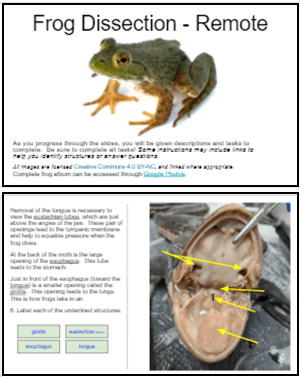
Students usually end the comparative anatomy unit with a dissection of a frog specimen. Though some schools have decided to opt out of this project, it remains one of the most remembered activities of the school year. I can understand why this project may seem like a relic, but it is still in our curriculum.
The pandemic of 2020 derailed this activity, and a percentage of students chose remote learning in 2021. I had to come up with a way for online learners to experience the dissection. In the past, I have used virtual interactive versions of the dissection, but many of those have been lost when Flash content was removed from sites.
I created this version to be interactive, though not as flashy, as those lost pages. I relied on my portfolio of frog dissection images to create a Google Slides version of the lesson. Each slide has an image, a description, and a task for students to complete. Most of these tasks ask students to drag labels to the image or answer questions about what they observe. In addition, students also view a video of a dissection and answer questions (EdPuzzle).
In-Person Dissection Option
Students in class will still be able to dissect a real frog specimen, though they will have the option to do the virtual version. I use this handout with directions for students to learn about the structures found on the frog and how to cut it. Students usually work in pairs or groups of three.
In both version, students will label a full image of a frog, though with slides, this was converted to a drag and drop version. The in-person students will label the frog on paper, though I do provide them with a word bank. You can find all of the labeling images on this page. The dissections focus mainly on the external anatomy of the mouth and head. Then students examine the digestive system, circulatory system, and urogenital system. I did include both male and female frogs in this exploration.
I look forward to an eventual replacement for the old Flash pages where students have a more interactive experience. Unfortunately, I don’t have the skills (or the time) to create it. There are several virtual apps for human anatomy, but I haven’t found one for the frog that is free and high quality. All the images used in the slides are my own personal photos I’ve taken over the years.

